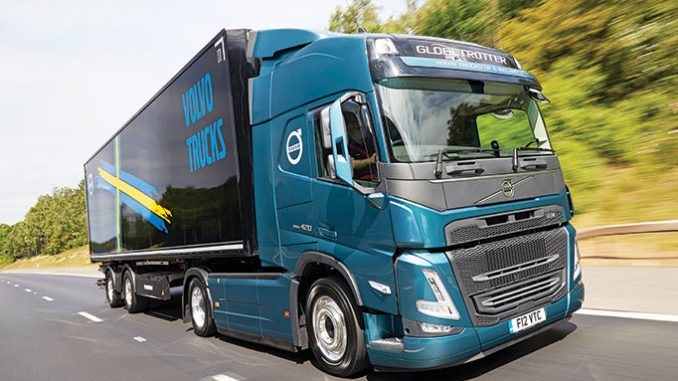
BETWEEN coronavirus lockdowns Volvo Trucks took the opportunity to get its new and revamped products out and about. The first of what will be several Volvo road tests through 2021 is the FM. There is a tinge of regret that this was not a 6×2, as that will be the real big seller, but for now a 4×2 will do.
Now, more than ever, FM looks and feels like its sistership, the FH. As the fifth generation of FM, the key differences from the current fourth edition of the genre are the all-new cab exterior and interior that now shares many aerodynamic improvements, styling and interior design with the newly updated FH range (TN, November 2020).
There is, of course, an economical benefit from reducing the number of individual parts and expanding the common parts portfolio and components, which helps lower the price tag, at least in theory.
What remains the same is the driveline; buy an FM and there is a choice between the Euro 6d 11 litre engine nominally available at 330, 380, 430 and 460hp badged rating or the 13 litre with the nominal 420, 460 and 500hp, and the G13K LNG (liquified natural gas) engine at 420 and 460hp ratings.
For this test it’s the D13K420, which achieves its Euro 6d rating using exhaust gas recirculation (EGR) and selective catalytic reduction (SCR). The in-line 6 cylinder lump delivers a true power rating of 414hp from 1,400-1,800rpm. A peak torque of 2,100Nm starts at 860rpm and meets the beginning of peak power at 1,400rpm.
This 4×2 pre-production model is geared up for fuel saving. At 2.31:1 it has the longest final drive ratio available in the UK, although a 2.17:1 option is available on suitable markets, and a 2.85:1 ratio is standard with the overdrive top-gear Dual Clutch unit.
It’s also worth noting the tyres, especially as the rubber of choice has traditionally been the 80 profiles. Fuel is one of the highest costs for haulage operators and industry trends are towards cleaner, ‘greener’ transport, with the EU Commission developing a road map to reduce the CO2 emissions from road transport, not to mention the UK’s own Road to Zero ambitions for 2050.
As such, the EU has developed the Vehicle Energy Consumption Calculation Tool (VECTO) that calculates the fuel consumption and CO2 emissions of trucks. Since 1 January 2019 all OEMs must declare the CO2 emissions for their new trucks sold on the European market, as calculated by the VECTO tool.
Currently, there are no A-rated 295/80R22.5 tyres available, and Volvo reckons the advent of the VECTO system will effectively force everyone onto 70% tyres as the default.
For this particular test, the FM is fitted with 355/50s on the front and 295/60s on the drive axle.
The Globetrotter is the highest of three roof heights, the others being standard low and extra low, and is the equivalent to the old LXL; the former cab known as Globetrotter XL is no more.
Unfortunately, cab height measurements are taken with trucks fitted with the 80 profile tyres; so, the new low roof sleeper is 2,865mm, whereas the standard day cab is 3,025mm, 65mm taller than the like-for-like FM Classic day cab. At the opposite end of the scale, the overall height of the FM Globetrotter is 3,395mm, 45mm taller than the one it replaces, and 95mm lower than the Classic Globetrotter LXL.
Everything above the top of the windscreen, inside and out, is shared with the FH which means a little structural change to the base of the cab. Using the FH blueprint for FM means it requires an all-new more vertical windscreen that generates an extra 1cu.m of interior cabin space. There are larger windows and a lower door line for better visibility, and FM is fitted with the FH’s slimline rear view mirrors.
Changes to the lower part of the FM cab measurements are subtle; the engine tunnel is 15mm higher at 445mm, and the cab floor height is 5mm higher from the ground compared to the now outgoing like-for-like model, rebranded Classic. So, based on 355/50R22.5 wheels and tyres as fitted here, the cab floor height is now 1,164mm.
With its parallels to the FH, it’s not surprising that the driving environment is also similar in the new FM albeit from a lower seating position. Combined with the larger windows, the aforementioned windscreen and mirrors, the driver can see more of what happens around the vehicle.
As Volvo Trucks current head of UK media, truck demonstration and driver development Martin Tomlinson explains, this particular truck being built on the medium height chassis with its current set of tyres ‘is eligible for three Direct Vision Standard stars’.
From the driver’s seat, the dominant feature on the dashboard are two digital screens, akin to what you see in the current Mercedes-Benz Actros.
In front of the driver is a 12in screen that relays the need-to-know functions that includes road speed, rev counter and fuel gauge, and the second is a 9in screen positioned within reach of the left hand that portrays navigation, infotainment and Dynafleet telematics information. As well as touch, the 9in screen can be operated by voice control or buttons found on the steering wheel.
This truck is fitted with the luxury pilots’ seat, which is well worth the extra few bob especially if the truck covers above average annual mileage.
The bottom bunk is positioned slightly higher than before, although it is also a tad narrower and 60mm shorter in length.
Heading north on the M74 from the border provides enough scope to pick out an engines’ weak spot. Rolling terrain that takes you past Ecclefechan sets out where the driveline will be working; here it’s around 1,100 and 1,200rpm. On the short sharp rises the engine prefers to lug although it did drop down a gear when passing J19, and home to The ‘fechan Diner’.
It lugged well down towards 1,000rpm on the long gradual climb towards Beattock after J15 and dropped a gear on both ascents before the plateau that precedes J14 and the underestimated climbs that occur before reaching the decline towards J12 at Uddington.
A word of praise is required for the Volvo Engine Brake (VEB+), which generates enough retardation to keep the legal road speed without excessive use of the foot brake to help it.
Coming back down the country via the A702 that passes through Biggar, the Volvo Dynamic Steering provided a greater feel of manoeuvrability, especially navigating the two tight roundabouts found at Penicuik and West Linton.
What this test provided was a window into what the Swedes see as a viable alternative to the ‘big tractor’ market, especially as FH was being bought and used in sectors it had not previously spun a wheel in before. Seeking better driver retention and a strong residual, the FH threatened to put the FM out to pasture.
Downsizing the Globetrotter to the old LXL is a nod to the mass market and offers it a degree of separation from the FH, if only in terms of specification. Despite that the Globetrotter has everything a driver needs bar a level floor across the engine tunnel to stand on.
Therefore, bringing FM into the fold with FH is a smart move as it should persuade operators seeking financial certainty to consider more appropriate acquisitions. For Volvo it brings down production costs by increasing shared components using a more modular design.
And the look and feel of the FM gives it a shot in the arm. It is more desirable, more driver friendly and comes with strong driveline options for it to even eat into some FH sales. It is a thoroughly enjoyable motor to drive and work in. You can order it now, production begins in 1 March 2021 with RHD chassis arriving in April.




